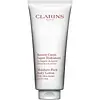What's inside
What's inside
 Key Ingredients
Key Ingredients

 Benefits
Benefits

 Concerns
Concerns

 Ingredients Side-by-side
Ingredients Side-by-side

Water
Skin ConditioningCocoglycerides
EmollientButyrospermum Parkii Butter
Skin ConditioningCoco-Caprylate/Caprate
EmollientPropanediol
SolventC14-22 Alcohols
Emulsion StabilisingCetearyl Alcohol
Emollient1,2-Hexanediol
Skin ConditioningC12-20 Alkyl Glucoside
EmulsifyingCetearyl Glucoside
EmulsifyingGlyceryl Caprylate
EmollientParfum
MaskingPotassium Cetyl Phosphate
EmulsifyingAcrylates/C10-30 Alkyl Acrylate Crosspolymer
Emulsion StabilisingEthylhexylglycerin
Skin ConditioningTocopheryl Acetate
AntioxidantAloe Barbadensis Leaf Juice Powder
Skin ConditioningDisodium EDTA
Sodium Hydroxide
BufferingActinidia Chinensis Fruit Extract
EmollientBetaine
HumectantSorbitol
HumectantPetasites Hybridus Leaf Extract
Skin ConditioningMitracarpus Scaber Extract
Skin ConditioningWater, Cocoglycerides, Butyrospermum Parkii Butter, Coco-Caprylate/Caprate, Propanediol, C14-22 Alcohols, Cetearyl Alcohol, 1,2-Hexanediol, C12-20 Alkyl Glucoside, Cetearyl Glucoside, Glyceryl Caprylate, Parfum, Potassium Cetyl Phosphate, Acrylates/C10-30 Alkyl Acrylate Crosspolymer, Ethylhexylglycerin, Tocopheryl Acetate, Aloe Barbadensis Leaf Juice Powder, Disodium EDTA, Sodium Hydroxide, Actinidia Chinensis Fruit Extract, Betaine, Sorbitol, Petasites Hybridus Leaf Extract, Mitracarpus Scaber Extract
Water
Skin ConditioningCoco-Caprylate/Caprate
EmollientPropanediol
SolventCetearyl Alcohol
EmollientSqualane
EmollientDicaprylyl Ether
EmollientGlycine Soja Oil
EmollientCetearyl Glucoside
EmulsifyingButyrospermum Parkii Butter
Skin ConditioningRetinol
Skin ConditioningRice Ferment Filtrate
Skin ConditioningCeramide NP
Skin ConditioningHydroxyethyl Acrylate/Sodium Acryloyldimethyl Taurate Copolymer
Emulsion StabilisingSodium Stearoyl Glutamate
CleansingEthylhexylglycerin
Skin ConditioningTocopheryl Acetate
AntioxidantTetrasodium Glutamate Diacetate
Leuconostoc/Radish Root Ferment Filtrate
AntimicrobialPhenoxyethanol
PreservativeTocopherol
AntioxidantLactic Acid
BufferingSodium Hydroxide
BufferingWater, Coco-Caprylate/Caprate, Propanediol, Cetearyl Alcohol, Squalane, Dicaprylyl Ether, Glycine Soja Oil, Cetearyl Glucoside, Butyrospermum Parkii Butter, Retinol, Rice Ferment Filtrate, Ceramide NP, Hydroxyethyl Acrylate/Sodium Acryloyldimethyl Taurate Copolymer, Sodium Stearoyl Glutamate, Ethylhexylglycerin, Tocopheryl Acetate, Tetrasodium Glutamate Diacetate, Leuconostoc/Radish Root Ferment Filtrate, Phenoxyethanol, Tocopherol, Lactic Acid, Sodium Hydroxide
 Reviews
Reviews

Ingredients Explained
These ingredients are found in both products.
Ingredients higher up in an ingredient list are typically present in a larger amount.
This ingredient is also known as shea butter. It is an effective skin hydrator and emollient.
Emollients help soothe and soften your skin. It does this by creating a protective film on your skin. This barrier helps trap moisture and keeps your skin hydrated. Emollients may be effective at treating dry or itchy skin.
Shea butter is rich in antioxidants. Antioxidants help fight free-radicals, or molecules that may harm the body. It is also full of fatty acids including stearic acid and linoleic acid. These acids help replenish the skin and keep skin moisturized.
While Shea Butter has an SPF rating of about 3-4, it is not a sunscreen replacement.
Shea butter may not be fungal acne safe. We recommend speaking with a professional if you have any concerns.
Learn more about Butyrospermum Parkii ButterCetearyl alcohol is a mixture of two fatty alcohols: cetyl alcohol and stearyl alcohol. It is mainly used as an emulsifier. Emulsifiers help prevent the separation of oils and products. Due to its composition, it can also be used to thicken a product or help create foam.
Cetearyl alcohol is an emollient. Emollients help soothe and hydrate the skin by trapping moisture.
Studies show Cetearyl alcohol is non-toxic and non-irritating. The FDA allows products labeled "alcohol-free" to have fatty alcohols.
This ingredient is usually derived from plant oils such as palm, vegetable, or coconut oils. There is debate on whether this ingredient will cause acne.
Due to the fatty acid base, this ingredient may not be Malassezia folliculitis safe.
Learn more about Cetearyl AlcoholCetearyl Glucoside is a surfactant and emulsifier. It can be produced from synthetic of natural sources of cetearyl alcohol and glucose.
Emulsifiers help prevent ingredients from separating, such as oils and waters. It can also be used to enhance the texture of products.
As a surfactant, Cetearyl Glucoside helps during the cleansing process. By gathering all the dirt and oils, it allows these molecules to be washed away easily.
Learn more about Cetearyl GlucosideCoco-Caprylate/Caprate is created from fatty coconut alcohol, caprylic acid, and capric acid.
It is a lightweight emollient. Emollients create a thin barrier on the skin to trap moisture in. This helps keep your skin hydrated and soft.
Once applied, Coco-Caprylate/Caprate is absorbed quickly and leaves a silky feel.
Coco-Caprylate/Caprate may not be fungal acne safe.
Learn more about Coco-Caprylate/CaprateEthylhexylglycerin (we can't pronounce this either) is commonly used as a preservative and skin softener. It is derived from glyceryl.
You might see Ethylhexylglycerin often paired with other preservatives such as phenoxyethanol. Ethylhexylglycerin has been found to increase the effectiveness of these other preservatives.
Propanediol is an all-star ingredient. It softens, hydrates, and smooths the skin.
It’s often used to:
Propanediol is not likely to cause sensitivity and considered safe to use. It is derived from corn or petroleum with a clear color and no scent.
Learn more about PropanediolSodium Hydroxide is also known as lye or caustic soda. It is used to adjust the pH of products; many ingredients require a specific pH to be effective.
In small amounts, sodium hydroxide is considered safe to use. However, large amounts may cause chemical burns due to its high alkaline.
Your skin has a natural pH and acid mantle. This acid mantle helps prevent harmful bacteria from breaking through. The acid mantle also helps keep your skin hydrated.
"Alkaline" refers to a high pH level. A low pH level would be considered acidic.
Learn more about Sodium HydroxideTocopheryl Acetate is AKA Vitamin E. It is an antioxidant and protects your skin from free radicals. Free radicals damage the skin by breaking down collagen.
One study found using Tocopheryl Acetate with Vitamin C decreased the number of sunburned cells.
Tocopheryl Acetate is commonly found in both skincare and dietary supplements.
Learn more about Tocopheryl AcetateWater. It's the most common cosmetic ingredient of all. You'll usually see it at the top of ingredient lists, meaning that it makes up the largest part of the product.
So why is it so popular? Water most often acts as a solvent - this means that it helps dissolve other ingredients into the formulation.
You'll also recognize water as that liquid we all need to stay alive. If you see this, drink a glass of water. Stay hydrated!
Learn more about Water